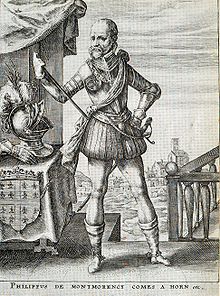Philip de Montmorency, Count of Horn




Philip de Montmorency (died 5 June 1568 in Brussels), also known as Count of Horn or Hoorne or Hoorn, was a victim of the Inquisition in the Spanish Netherlands.
Biography
De Montmorency was born, between 1518 and 1526, to Josef van Montmorency, Count of Nevele and Anna van Egmont the Elder.[1] His father died in 1530 in Italy, and his mother remarried Johan II, Count of Horn, one of the wealthiest nobles of the Netherlands, who, in 1540, left the County of Horne to his wife's children on condition they assume his name.[1] A page and later chamberlain at the court of Charles V, de Montmorency married Walburgis van Nieuwenaer in 1546. He became stadtholder of Guelders in 1555, an Admiral of Flanders, and a knight of the Golden Fleece in 1556.[2]
In 1559 he commanded the stately fleet which conveyed Philip II from the Netherlands to Spain, and he remained at the Spanish court until 1563. On his return he placed himself with the Prince of Orange and Count of Egmont at the head of the party which opposed the imposition of the inquisition by Cardinal Granvelle and ultimately forced his resignation.[3] When Granvelle retired, the three nobles continued to resist the introduction of the Spanish Inquisition and of Spanish rule in the Netherlands. Although Philip appeared to give way, he had made up his mind to punish the opponents of his policy. The regent, Margaret, duchess of Parma, was replaced by the duke of Alva, who entered the Netherlands at the head of a veteran army.[3]
Orange fled from the country, but Egmont and Horn, despite his warning, decided to remain and face the storm.[3] They were both seized, tried at the Council of Troubles and condemned as traitors.[3] Ceaseless but vain efforts were made to obtain a fair trial for Horn, and appeals for clemency on his behalf were made by potentates in all parts of the continent.[3] Egmont and Horn were executed by decapitation on 5 June 1568 at the Grand Place before the town hall in Brussels.[3]
Legacy

Nowadays, a statue erected on the Petit Sablon Square in Brussels commemorates the Counts of Egmont and Horn (Hoorn, Hoorne), in historical overview usually mentioned together as Egmond en Hoorne and hailed as the first leaders of the Dutch revolt, as the predecessors of William of Orange, who grew to importance and obtained the leadership after their execution, and who was assassinated in 1584 in Delft, having succeeded in liberating parts of The Netherlands in the early years of the Eighty Years' War (1568–1648). [citation needed]
Van Egmont ("Egmond") and De Montmorency ("Horn" or "Hoorn"), both remained faithful Roman Catholics and are commemorated in Belgium, with its traditional Catholic majority. William of Orange, brought up as a Lutheran, was a proponent of freedom of religion.
Notes
- ^ a b Albertus van Hulzen, De Grote Geus: en het falende Driemanschap, (Typographie Rombus, 1995), 7 note1.
- ^ John B. Roney, Culture and Customs of the Netherlands, (Macmillan, 2009), 22.
- ^ a b c d e f Lamoral Graaf von Egmont, Spencer C. Tucker, 500 Great Military Leaders, ed. Spencer C. Tucker, (ABC-CLIO, 2015), 219.
References
- Chisholm, Hugh, ed. (1911). . Encyclopædia Britannica (11th ed.). Cambridge University Press.
- Rines, George Edwin, ed. (1920). . Encyclopedia Americana.
- Use dmy dates from July 2013
- 1568 deaths
- 16th-century Dutch people
- Dutch expatriates in Spain
- Admirals of the navy of the Dutch Republic
- Counts of Hoorn
- Knights of the Golden Fleece
- People executed for treason against Spain
- Executed Dutch people
- House of Montmorency
- People executed by Spain by decapitation
- Dutch Roman Catholics
- People of the Spanish Netherlands
